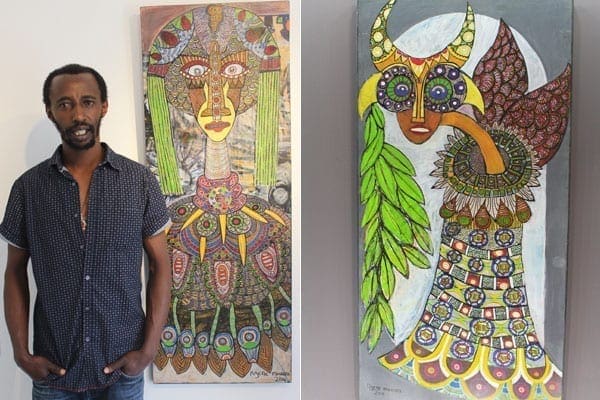
Coming home to Kenya after living abroad for more than a decade (studying, working and painting full-time) was Ngene Mwaura’s choice.
Yet it hasn’t been easy as the artist revealed recently during an ‘Artist Talk’ on the last day of the first solo exhibition that he has had since returning from Los Angeles, US, where he has worked both as a graphic designer (creating everything from music album jackets to book illustrations) and a full-time artist.
His show entitled, ‘Reclamation,’ bespeaks the challenging nature of his journey as he’s tried to ‘reclaim’ his past while keeping his eyes focused on the present and the future.
Looking at his art, one might not see the struggles he has undergone. But having recently lost both his parents, he spoke freely about his father’s passing on just days before his return, suggesting it felt like an injustice for his dad to exit just days before he was to return. And in homage to his mother, he had painted one of the most beautiful pieces in the show.
In nearly all the paintings in ‘Reclamation,’ one will find Ngene’s multi-layered concept of an African mask. His mother’s ‘portrait’ is no exception except that he includes a kind of torso in her painting as well as symbolic features of her busy rural life; she was a diligent dhania farmer whom, he said, used to put him to work weeding her garden whenever he was with her on the family farm.
What makes his mother’s portrait the most personal of all his paintings are the three baby faces that seem to hover around the central mask of his mother in the work. Each ‘face’ represents one of her children, he said. One was himself, the others were his older brother and younger sister.
ATTENTION TO DETAIL
Recalling fond memories of life with his mum on the land, Ngene observed: “I think probably my having to differentiate between the weeds and the dhania from an early age is one thing that taught me to be so attentive to detail as I am today,” said Ngene, whose masks are distinctive for their meticulous attention to detail and variegated design.
Clearly, he was extremely close to his mother, and he admits he feels quite lost coming home to a world without them. Yet the exhibition also suggests that the one constant that he’s got in his experience is his art and especially his passion for painting and drawing.
Yet, if Ngene currently has a passion for African masks, be assured that his are anything but traditional (or ‘tribal’). Instead, they are delicately detailed, multicolored, multi-patterned, and nearly symmetrical in his usage of colours, designs, patterns, and facial features. What’s more, they have a sort of psychedelic feeling about them that defies their being classified or categorised as purely ‘African’. I’d call them afro-futuristic.
Asked at the Art Talk how he could do such detailed, meticulous design work if he weren’t a terribly patient man, Ngene was quick to insist that he was actually highly impatient, except when it came to his art. In his painting (with an acrylic paint pen), he said the intense, highly detailed work that he does is a form of ‘meditation’ which gives him a sense of peace and comfort.
Most of Ngene’s paintings that were in the Art Space show are similar to ones he sent to Kenya from the US just over a year ago for an exhibition held by Carol Lees at the at One Off Gallery. Both shows reflect the artist’s intensely personal attention to detail, design and a wide range of bold and beautifully diverse colours. Most of those works have been masks with big, bright, penetrating eyes as well as lashes, brows, noses, broad foreheads and enigmatic mouths that seem to be telling incredible stories.
One thing that Ngene is clearly going to miss from his life in Los Angeles is the countless live music concerts and festivals that he frequently attended, and made arrangements in advance with the live performers or the DJs to let him have space on stage to paint in tandem with the music, using his magic pen like a musical instrument.
But Ngene has already made his way to at least one local music concert and his Art Space show featured several fine-line drawings from that experience. The five or six miniature sketches could easily foreshadow a promising future where the artist will again be able to paint along with percussionists and DJs, only now he may be in Mombasa, Nakuru, Nairobi or even Nyanza, and not in LA. But only time will tell.
Source-nation.co.ke







